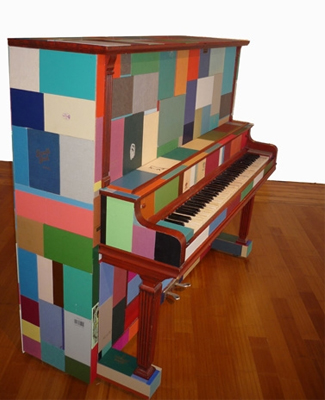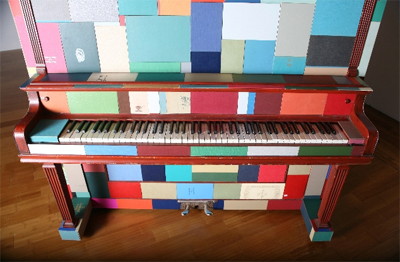The other day, the store was busy and I answered the phone cheerily enough. The woman on the other end played to my ego: “You’re so good at recommending, I was wondering if you could make some suggestions for my five-year-old.” I was more than happy to help.
Yearly Archives: 2010
Book Culture Mash-Up: Jane Austen Fight Club
Elizabeth Bluemle - August 9, 2010
A tidbit for a Monday morning: this very funny video re-imagining the world of Jane Austen if it included Fight Club. I am a sucker for a good mash-up (but there are very few really well-executed ones).
Jane Austen Fight Club
What children’s book mash-ups would you like to see? I’m thinking Babe the Gallant Pig / Top Chef. (Oh no I di’n’t!) Or how about Flowers for Algernon, where Charley meets The Runaway Dolls? (Hey, I never said they were good ideas.) Josie suggests Horton Hears a Who and Machiavelli’s The Prince.
What should the next YouTube book mash-up blockbuster be, hmm?
Nancy Werlin: The Anatomy of a Book Cover
Elizabeth Bluemle - August 5, 2010
When we ran a post in ShelfTalker recently about young-adult book covers—The Season of Windblown Hair — Or, the Zeitgeist of Book Covers—author Nancy Werlin wrote us a note. She said, “Elizabeth’s recent cover post sparked me to write something about covers from an author’s POV. ” Attached to her note was the article that follows this introduction; it’s a revealing, behind-the-scenes look at the kind of conversations established authors have with their editors (and agents, and others) during the cover design process. We are delighted to add her voice to the conversation about how book jackets are designed and changed and edited until they are approved and ready for the bookshelves.
[Note: Not all authors are invited into the cover design process; perhaps even the majority are not. Publishing houses have varying policies about author participation in book cover and art discussions, and newer authors generally have less input than well-known authors with more experience in the industry, like Nancy.]
And now, without further ado, here is:
Anatomy of a Cover: Extraordinary by Nancy Werlin
Part 1. Thrifty R Us
So, I was having breakfast with my editor, Lauri Hornik at Dial/Penguin, at the ALA convention in June, and suddenly Lauri lowers her voice and says, “Did you see that story in Publishers Weekly about the YA cover shoot?!”
“You bet I did,” I say. “Ack!”
“They spent over $20,000!”
“$28,000!” [Note: It was actually $26,000. I have a tendency to exaggerate for the sake of the story.]
“In fairness, it was for four covers. But still! Can you imagine?”
“No!”
This explains why, in talking about the cover of Extraordinary, I will be discussing stock art, PhotoShop, and the genius of in-house cover designers – in this case, Natalie Sousa at Penguin. I also have to mention interior designer Jasmin Rubero, because Extraordinary has a lovely page design too.
Part 2. Cover Design Mission
There was a mission: To match the cover of Extraordinary to the cover of the paperback Impossible,  which was commercially successful. Consider the outdoor natural setting, the single girl in motion with her hair blowing, and the cursive font used for the title; both covers have these in common.
which was commercially successful. Consider the outdoor natural setting, the single girl in motion with her hair blowing, and the cursive font used for the title; both covers have these in common.
Conceptually, though, the “same but different” mission was tricky for the designer. You couldn’t have the cover of Extraordinary suggest to readers that they’d be getting the continuing adventures of Lucy Scarborough from Impossible, only that they are likely to get a similar reading experience.
Then there’s the mission of any cover: to represent the book’s contents authentically enough while appealing to the tastes of those most likely to want to buy it and read it.
“Authentically enough.” What do I mean by this? Well, I’m a veteran of YA book covers (just take a look at my website’s Cover Gallery, in which you’ll find my sometimes trenchant comments on the covers of my books over time). I used to want covers that represented the book’s contents very closely, and were also pretty. Many folks automatically believe that this is what makes a good cover.
But I’ve changed my mind about this. While the cover should not lie (by implication or outright), its job is simply to say: “Pick me up!” to someone who might like the book. That is all. And you have more moving parts than the art: you also have the title and author’s name.
Part 3. The Right Stock Photo
I can only guess how long it took Natalie to find the right stock photo. I imagine she typed “young girl” (and maybe some other keywords) into many different stock photo sites and scanned and scanned and scanned through the results. In the end, she found it at Agenja Free/Alamy.
If you click on the stock photo website link, you can perform the search. Enter “young woman forest” (don’t use the quotes). You’ll see a selection of photos that includes the green forest glade from the Extraordinary cover. (Or you can just look at the picture of the search results.)
On the second page, you’ll find the photo that Natalie used, and you’ll see a few others of that same blonde girl in a red dress frolicking in the forest. There’s one of the girl running toward (rather than away from) the camera; one of her holding her dress out; a few of her sitting in the grass; one of her dancing in sort of a demented way. Maybe Natalie considered some of those as well.
In any event, she created a mock-up (one of many, no doubt) which was the one that Lauri first sent to me.
Part 4. Actual E-Mail: Cover Mock-Up #1 … and #2 … and #3 … and the Final Decision
Here’s the actual email dialogue that followed.
LAURI (to Nancy): Here’s a jacket-in-progress (#1).
I’m not liking the hot pink color of the dress and shoes, and I’m thinking that we’ll want some shimmer effect for punch and to hint at the otherworldly setting. What do you think? Could this girl fairly represent Mallory? And do you like the general look of this? We are, of course, trying very specifically to give the novel a companion look to the IMPOSSIBLE paperback.
NANCY: Hm. Interesting! Yes to giving it a companion look to IMPOSSIBLE. And I think this “pops.” But it’s also a little too running-girl-Gothic for me. (Remember those old ’70s romance paperbacks? They always showed a girl in peril, running in a dress.)
I like the green landscape and the high heels. I agree with you about not liking the hot pink color in the dress.
Yes, that could be Mallory, who’s described as having straw-colored hair. But is there a way to make the cover indicate *two* girls? I don’t actually like having Mallory only on the cover; she’s not the main character. If only one girl is shown, it should be Phoebe.
GINGER KNOWLTON (agent): My favorite part is the title font. I immediately thought that I would want a handwriting expert to interpret it.
15-YEAR OLD TEEN: It doesn’t fit the description of Phoebe. And… the girl looks obnoxious… as do the colors. Buuuuuut that’s just me. I would rather see an image of a girl standing in the garden with Phoebe’s description – short with wild red-brown hair or even Mallory with a pair of wings… but yeah… that’s just my snobby opinion. 😛
NANCY: The most salient detail, to me, is that our teen expects to see Phoebe, not Mallory. And she’d rather see a garden than a forest.
LAURI: Thanks, Nancy. This is helpful. We’re limited, in terms of setting and girls, by what we can find as a stock image. But I do think Natalie can work some magic with PhotoShop. Stay tuned.
LAURI (to Nancy): Here’s the other jacket comp that we’ve been thinking about recently. Would love to hear your thoughts.
NANCY: [Answer lost in the bowels of email, but it was something on the order of, “Dear God, no.”]
LAURI: Here’s a third cover option — one that I love. What do you think?
NANCY: I like everything about it except the girl. The forest atmosphere is terrific. Would it be possible to swap in a different girl or change her clothes?
LAURI: I know — it’s nothing that Phoebe would wear. I’ll ask Natalie if there’s any way to change the outfit. But can we get away from having Phoebe in all black? Any other options? [Note: In the novel, Phoebe wears nothing but black. But it turns out that this is not the best visual choice if you want your cover girl to be striking.]
LAURI (presenting final cover, showing original girl who now has reddish hair and is wearing black): After much discussion, we’ve decided that the attached comp is the strongest:
We did look at inserting other girls into the photo that had the grand trees and the pinks in the sky, but it looked awkward, and Sales found that photo too introspective/quiet to have shelf impact. This one was forcefully preferred by the group, and with the outfit a different color and her hair more Phoebe-ish, I feel very good about this one. Some questions: Do YOU feel good about this one? Does this girl look enough like Phoebe? And how do you feel about the new title type? The previous version, as gorgeous as it is, was too difficult to read.
NANCY: Well, “forcefully preferred by the group” is a strong argument for me. This #1 had been growing on me since I first saw it, and I suspect it will grow on me even more over time, as did the IMPOSSIBLE cover. Yes, I do think this could be Phoebe now — and that’s quite important. And I love how this cover matches with the IMPOSSIBLE cover.
(And I adore the shoes. This cover asks the important and perhaps irresistible question: Why is she running through a glade in THOSE SHOES????)
The original title font was so lovely, I mourn it, but I can live with this. It gives the same feel, almost, and it IS easy to read.
In short: I am on board, too.
LAURI: The color of the outfit makes a BIG difference in the tone of the whole. I feel it gives the book the solidity, the gravitas that it deserves, and that it doesn’t any longer look like popcorn. The group at the meeting this week all agreed, and they seemed whole-hearted.
NANCY: One question: can we have a line or two about the plot on the back cover? I just read an article that explained that many kids don’t know to read the flap copy. They look on the back and then put the book back on the shelf if it doesn’t contain some hint of what the book is about.
LAURI: Absolutely!
Part 5. Cover as Magic
I now look over the above exchange with bemusement. Why didn’t I immediately see that the first cover composite was on the right track? That it was going to be gorgeous, and fitting?
Maybe I was scared. Writers put a lot of weight on their book covers. I couldn’t see clearly through the haze of my emotional investment in Extraordinary. Did this cover express everything that I felt about my book? About Phoebe Rothschild, her friend Mallory, and everything that happens between them?
Well, how could it? Extraordinary is an original fairy tale, a contemporary story. But like a traditional fairy tale, it heads quickly into frightening, bloody territory. I am afraid for my book, as it goes out alone into the world, just as I was frightened for Phoebe as I wrote and rewrote her story.
No matter how beautiful and loved a cover may be, the jury on it remains uncommitted until the book has been in the world for a while. Perhaps bookstore buyers will be indifferent. Perhaps it will be lost on store shelves. Perhaps there’s another book or two out there using the same or a similar photo. Perhaps its concept or color scheme is part of a trend that’s suddenly over. Perhaps ShelfTalker at Publishers Weekly or the anonymous designer at “Jacket Whys” or other bloggers will rip it to shreds for a reason never imagined during the design process.
And then there is the inside of the book.
A book cover says “open me.” The opening of a particular book will be magic for some readers; but for others, it will not. And about these others the author must learn to say, “My book, my beautiful book, was not written for them. They will find their magic elsewhere, and that’s just as it should be.”
It’s ever so slightly hard, however, to get to this place of acceptance. And so the author hopes that the cover will itself be magical, attracting all the right readers, and as few as possible of the wrong ones, to what really matters: what’s inside the cover.
***
Selling Books in One Line or Less
Elizabeth Bluemle - August 3, 2010
Most booksellers have had this experience at least once or twice in their careers: selling a book based on a single sentence uttered to a receptive ear. It’s a rare and delicious triumph of communication, a gift given by the booktalking muse, and it delights customers as much as it delights booksellers.
Sometimes, a book provides you with that magical line—often its first sentence—and all one needs to do is read it aloud to a customer and the book is sold. For instance, Frances Marie Hendry’s marvelous Quest for a Maid begins with this stunner: “When I was nine years old, I hid under a table and heard my sister kill a king.” That’s all a kid needs to hear to want to read that book. The same is true of Avi’s True Confessions of Charlotte Doyle, which starts thusly: “Not every thirteen-year-old-girl is accused of murder, brought to trial, and found guilty.” The reader is hooked like a pike on a piece of year-old Velveeta.
Not every great first line is enough to sell a customer on a book, though. Perhaps the most famous first line in children’s literature is “Where’s Pa going with that ax?” from E.B. White’s Charlotte’s Web. The line certainly earns a reader’s riveted attention, but a bookseller definitely has to add a little bit about Charlotte and Wilbur to that booktalk (at least, if the customer has been living on Neptune for the past century and doesn’t already know the book). And a little extra description is required for one of my favorite first lines, from M.T. Anderson’s Feed: “We went to the moon to have fun, but the moon turned out to completely suck.” It’s a perfect piece of immediate world-building, but doesn’t give a customer a sense of the plot — so you need a second sentence. But that’s all it takes.
In our store, the most common single-sentence sales come from simply saying that one of our booksellers loved it. These aren’t bookstore-muse-inspired one-liners, but it’s certainly gratifying to make sales based on that level of trust our customers have for our staff members.
The key to the one-liner is that it has to lure the reader with something irresistible, something intriguing or powerful or magical or mysterious that invites a deeper relationship with the book. It also has to be sincere, enthusiastic, and heartfelt. I’m sure the expressions on our faces that sell books as much as the words we use. People can see it in your eyes when you’ve loved a book, lived it, want to share it with others. Here are some of the one-line (or one-phrase) descriptions we give that seem to do the trick for readers.
The Boxes, by William Sleator: “A boy’s mysterious uncle gives him a package to hide, instructing him never to open it—and then the box in his closet begins to tick.”
A Barrel of Laughs, A Vale of Tears, by Jules Feiffer: “There’s a prince so silly that everyone falls down laughing near him, so his father the king thinks he’ll make a terrible ruler someday and sends him on a quest to be serious.”
The Hunger Games, by Suzanne Collins: “It’s got a really brutal premise, but it’s amazing.” That’s enough for kids. For writers and teachers, I add: “and it’s the most perfectly paced book I’ve ever read.”
Life as We Knew It, by Susan Beth Pfeffer: “A meteor hits the moon off-course, causing major natural disasters, and a typical teenage girl’s whole life, everything she’s ever known and counted on, begins to unravel.” That’s enough to hook a reader, and as we walk toward the front desk, we like to add that it’s a one-sitting read, and that the customer is going to start obsessing about survival supplies.
Gerald Durrell’s My Family and Other Animals: “It’s like reading bottled sunshine.”
The Count of Monte Cristo, by Alexandre Dumas: “This is a great summer read: an epic potboiler full of betrayal, revenge, prison escapes, duels, star-crossed lovers, rags and riches.”
The Last of the Really Great Whangdoodles, by Julie Andrews Edwards: “Three kids meet this funny little professor who needs their help to get to the magical Whangdoodleland and rescue the last whangdoodle.” For adults, I add: “And it’s by Julie Andrews, one of the few celebrities who writes beautifully for children.”
Mrs. Biddlebox, by Linda Smith and illustrated by the inimitable Marla Frazee: “It’s the perfect book for anyone who’s caught in a black cloud at the moment, and the illustrations are remarkable.” I love this book so much, and always felt it didn’t get the attention it deserved.
Weslandia, by Paul Fleischman: “A boy who’s kind of a loner, and not like most other kids, is incredibly original and starts building his own society, which unexpectedly brings him all kinds of friends.” (This one works well because every kid feels different from other kids, and wants to create a world where everyone belongs. Or, um, was that just me?)
The nearly wordless sell:
I think Josie has written about this exchange before, but it was such a funny/wonderful bookstore moment that I’m repeating it. She had recommended Markus Zusak’s The Book Thief to a customer, commenting that it was in my personal top ten or twenty favorite books of all time. The customer came up to the counter, caught my eye, and said, “It’s really that good?” All I did was look at her, my face revealing, I guess, every bit of the awe and power and compassion and sorrow and humor that book conjures up for me. “Sold!” she crowed, and plunked down her fifteen dollars. We all just laughed. That’s some book.
How Rocket Learns to Read, by Tad Hills: Show them the cover. That’s it. (It’s easy to come up with a single line to recommend this one, too, though.)
Booksellers and librarians and teachers and readers out there, what are your most successful one-line booktalks?
A Cautionary Tale
Josie Leavitt - August 2, 2010
While on vacation this past week, I was reminded anew the importance of customer service, or lack thereof, and its effect on the customer. I was happily browsing and chatting, not loudly or about anything other than books, in the back of this store, when the sole worker approached me and my two friends and said pointedly, “Could you please keep it down.” This was punctuated with a withering look as he went to the store room.
I was stunned. Not only were we not being loud or inappropriate, we were in a bookstore, not the reading room of the Library of Congress. To be shushed in a store when I was hardly speaking above a whisper really chilled me. So much in fact, I put the book down I was thinking of buying and left, and I never went back the rest of the vacation, and this is a store that I always try to patronize when I’m on the Cape. This experience brought home to me that one bad experience can sour a customer on a store, sometimes forever. As a store owner, I got to thinking about the old adage I always hear about customer service: if someone has a great experience they tell three people about it, if they have a bad experience, they tell nine people. That’s a horrible ratio, which bore out with the shushing experience.
A good bookstore should be many things, but most of all it should be welcoming. Happy customers chatting about books makes the store seem vital and alive. A silent store makes people nervous. I’ve actually said, in a loud whisper, “You don’t have to whisper. It’s a bookstore, not a library, really it’s okay to speak.” Children usually laugh when I say this and parents visibly relax. Being able to have a conversation is HUGE in a bookstore. Bookstore inspire discussion and discussions should not be hushed. One of the things I love best about the Flying Pig is when customers join conversations and complete strangers are talking about why they loved, or hated, a particular book. It’s invigorating and I love to hear what everyone’s got to say.
A bookstore is a tiny community within its town. People come in expecting to be able to browse and to chat, and that’s how it should be. I can honestly say that in fourteen years of business, I’ve never shushed anyone, and if I ever do, it’s time for me to get a new job.
More Ways to Bring Books to Your Home
Alison Morris - July 30, 2010
Gareth and I are just THREE days away from our Manhattan move and doing a feverish dance of both packing boxes and purging possessions. Moving to an apartment that’s two-thirds the size of your current place turns out to be a logistical headache that’s about the size of, say, Central Park. And just as easy to get lost in.
BUT, we are making progress! And by Monday evening we should be newly installed in our new apartment, new city, new state, new lives. (The very thought of that makes a little panicky, but it’ll be great, right? Right. That’s what I keep telling myself!) In the meantime, we have been trying to solve various household logistical problems like trying to find ample space for Gareth’s studio AND for houseguests, finding furniture that will work in a bedroom that will be almost entirely filled by our bed, and so on. With furniture and housewares on the brain, I thought I’d feature a few items I’ve come across in my in-person and on-the-web travels that might have particular appeal to book lovers.
The first of these is an unexpected and relatively inexpensive find. No more do you have to relegate your book love to the living room, bedroom, office, and kitchen of your house, as Kohls sells this shower curtain, allowing you to feature stacks of books in your bathroom too.
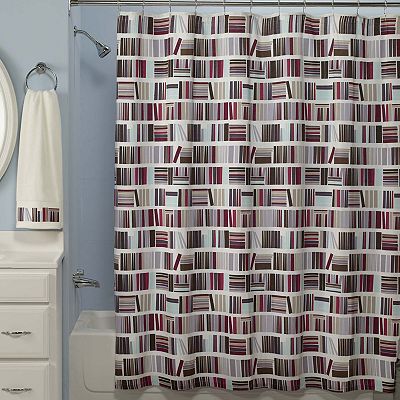
And speaking of stacks of books… In honor of their Billy bookcase’s 30th birthday, Ikea created a limited edition version that features snippets of love sonnets by Shakespeare, penned in graffiti-like fashion by designer Annika Bryngelson. Clever? Not clever? You decide. First though, note that it’s not all’s well that ends well with this bookcase, as some of the quotes in its design are falsely attributed to the Bard! Argh!! I suspect Ms. Bryngelson (or the person who fed her the lines that later flowed from her pen) did her “research” for this design via the internet. Tsk tsk. Commence finger wagging.
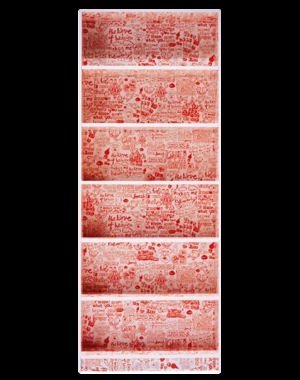
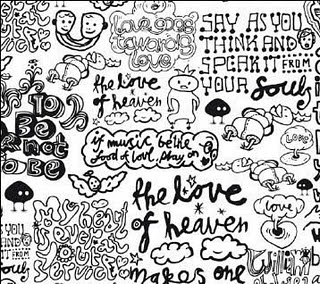
The Billy Jader bookcase featured above comes in 3 different colors, whereas MY favorite item of book-modified furniture comes in FAR, FAR more than that. Artist Mike Stilkey used the covers of old books to “augment” this piano, with which I am very much in love. (sigh) And what book does it make me think of…? (This should be an easy one, folks!) Mysterious Thelonious by Chris Raschka. (Listen to it free online!) Ten points to everyone who guessed correctly. If you had a different idea, I’d love to know what it was.
Finding room for this piano might be a challenge in smaller spaces, but you can still look to Mike Stilkey to bring books to your space on a much more manageable level, size-wise. He does paintings on the spines of books that would fit nicely on almost any wall. (Seeing these makes me REALLY want to line up a stack of library discards and break out the paint!)
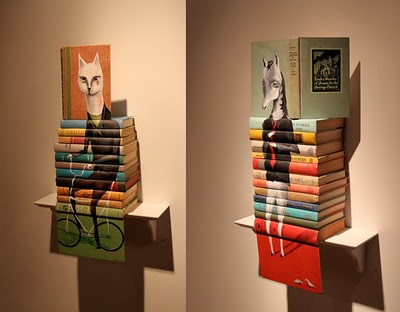
Artist Laura Cahill is also finding at-home inspiration from books. I am personally coveting her Heavy Read stool (and, yes, you can actually sit on it!), but maybe you’d be more keen on her Reading Lamp (in photo next to stool — yes, it’s made out of books) or one of her Book Vases?
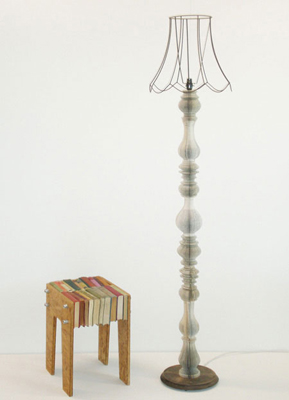
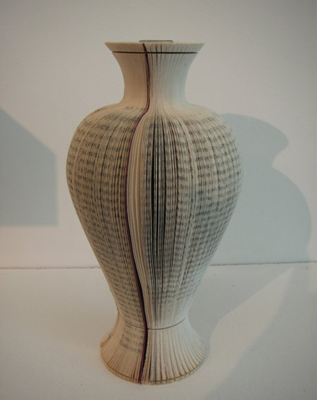
Normally I would say that fungus is NOT something you want to have in your home. But faux fungi made from handmade books? That’s another story! I love these fantastic paper sculptures created by Melissa Jay Craig for her (S)Edition exhibit at the Morgan Art of Papermaking Conservatory and Educational Foundation in Cleveland. If you’re enamoured with them too, note that in a blog post back in February, Melissa said, “I am searching for a 2010 venue for (S)Edition, and I would love to see it in an alternative to the gallery; I would love to see all 99 copies installed in a working library, for instance. Any ideas, anyone?” Those of you with ideas can comment on Melissa’s post or get in touch with her using the contact info on her website. Be sure to also check out her Current Portfolio, where you’ll find more remarkable book art.
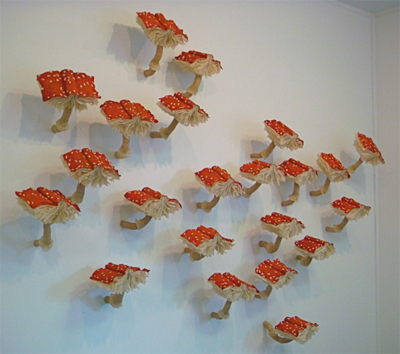
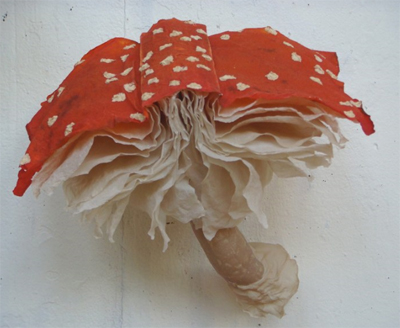
And one more wall suggestion: I left Wellesley Booksmith before I’d been able to read the picture books on all the major publishers’ fall lists, but my brief visit with the Houghton Mifflin Harcourt kit had me oohing and ahhing over the incredible woodcut illustrations Rick Allen created for Joyce Sidman’s forthcoming book Dark Emperor and Other Poems of the Night (September). The art he created for this book matches the beauty of Joyce Sidman’s poems, which is (as you all know) is an EXTREMELY high compliment! Wanting to see more of Rick’s work I visited the website for his studio, the Kenspeckle Letterpress, where I fell in love with print after print after print. Pasted here are a few of my favorites, but WOW was it hard to choose! This is one “newcomer” to the children’s book world who is clearly not a newcomer to the art of wood engraving. I predict that an onslaught of contract offers will soon be headed Rick’s way…
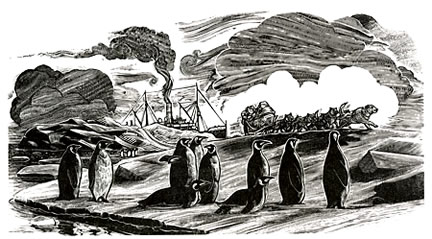
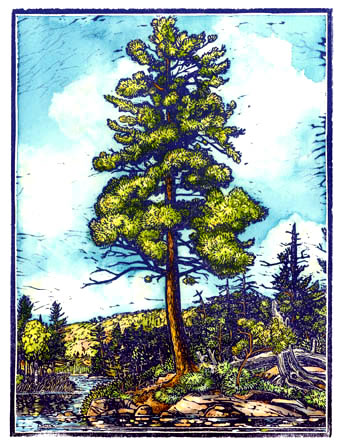
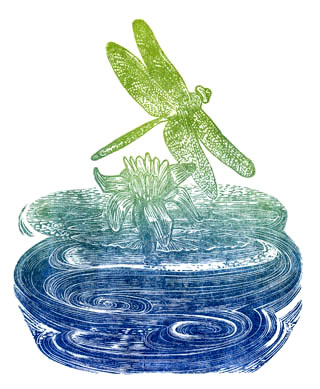
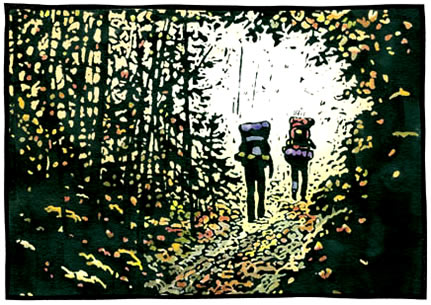

And now… Back to packing!
Another Way of Working with Teachers
Josie Leavitt - July 29, 2010
Every independent bookstore needs to distinguish itself from the chains and online retailers. One really effective way to do this is to provide a service the competitors can’t: you and your knowledge. I’m not talking about handselling or customer service, I’m speaking of providing teachers with their mandatory continuing education credits.
This August Elizabeth and I will be leading two days of in-service training for our local school district. I don’t know yet how many teachers will sign up, but since the district pays for it so it’s free to teachers, I suspect we’ll have a good turnout.
I approached the head of Curriculum Development for the our local district in April about my desire to work together. She was incredibly receptive and really wanted to “keep it local.” She told me what the district needed in terms of hours, content to be covered and what they could pay us. Elizabeth and I then submitted proposals and now we’re planning our sessions.
The real beauty of this is tri-fold. First, we have a captive audience of teachers, many of whom might not be familiar with the Flying Pig, so it’s chance to gain new school orders. Second, we have a chance to really showcase our knowledge of books, which the teachers can use in their courses that fulfill the Vermont curriculum guidelines. Thirdly, I think it will be a great thing for us, and our staff, to know better the Vermont educational goals for each grade. This does not change by district, so I will be more able to help any Vermont teacher find interesting, new books they can use for instruction or enrichment.
Working with the school district makes it easier for us because they do all the work. They set up the dates, they do all the paperwork and coordination. We just work very hard to make the presentations meaningful and fun.
I’ve been going through all my buying sessions this summer with an eye toward the curriculum in a way I never have before. Historical graphic novels I might have passed on, I’m now considering more closely. The fun part of preparing for this is seeing how to think outside the box. Can fantasy novels be used to help explain government and societal changes? Totally. My goal with my educational sessions is to present, essentially booktalk in-depth, with supplemental ideas, books that will help social studies and language arts teachers meet the curricular goals they have to set before them. Each teacher will get a goody bag of some kind. We’ve got lots of posters and teacher materials to give away, will which hopefully be meaningful for the teachers, besides, who doesn’t like free things?
It’s actually really exciting for me to help teachers plan part of their year. Teams come together to plan out units. So, we could see a unit develop at the session based on some of the new books we’ll be presenting. I think that’s really powerful and I can’t wait. The goal of this is to make real human connections with teachers in third through eighth grade, and hopefully these connections will last into ordering season. After the presentations, I’ll post an update on how it went. For now, I’ve got my notebook with me everywhere and I’m a note-taking fool.
Crying in Public
Josie Leavitt - July 27, 2010
I think it’s happened to all readers with a heart: you’re reading in public, say a plane or train, and suddenly you find yourself in tears because of what’s happening in your book. I found myself in just this situation last week on a plane to Chicago.
I was reading a galley of Sorta Like a Rock Star and I was overtaken and just started crying, a little at first and then a little bit more. I had no tissues, napkins or anything to wipe my eyes or nose with, so I resorted to dabbing at my eyes with a spare scrunchie that was wound around a my wrist. Luckily, I had no seat mate, but I had a very concerned flight attendant who checked in with me, not once, but twice. Clearly she didn’t believe me about being so moved by a book, I just had to weep a little. Each time I waved her off. Finally, I just had to put the book away for fear I’d struck some main line of tears, and as much as I was enjoying the book, I didn’t want to cry all the way to Chicago.
I know I have customers come into the store very angry with me because they outright sobbed at the last thirty pages of The Book Thief while they were flying home from vacation. “Why didn’t you warn me?” Well, telling customers when they’re likely to sob during a book isn’t part of my job. Although, I will say, I have amended my handselling for The Book Thief to say, “If you have a heart, you will cry at the end of this book. Be mindful of that when you’re on a plane.”
I must say, even crying at home can cause concern. I was reading Harry Potter and the Half-Blood Prince outside on my deck and I was sobbing so hard at the death of Dumbledore, I could barely contain myself. I just wasn’t expecting him to be, you know, totally dead. I just sobbed. First my dogs came out to see if was I was okay. Then Elizabeth, who knew what I was reading, came out with a box of tissues.
Books should move us. A good book can give us the whole range of human emotion. The good thing for me is I’ve got Christopher Moore’s Fool to read at the beach during vacation, so hopefully people won’t be concerned for me, they’ll just think I’m a lunatic for laughing at every page.
Special Order Messages
Josie Leavitt - July 26, 2010
I think everyone views their bookstore a certain way. I always think of the store as the Flying Pig. So, when I call people about special orders it’s always fascinating to hear we’re actually called when messages get relayed. We make a point to say “Your book is in.” We never tell the title, because, as I like to say, you only need to ruin someone’s birthday once and you’ll never do it again.
– One husband just says, “It’s them again.”
– We’re often referred to as, “the Pig for you.”
– “Your book’s in at the Pig.”
– “It’s the lady (am I old enough to be a lady? when did that happen?) from the bookstore.”
– “It’s Elizabeth from the bookstore.” Gets shouted to someone in the house. No, actually, it’s Josie, but folks are forever confusing us. People actually get mad when they find out we’re not sisters, or in some case, twins. Really? If you look closely, there’s nothing twin-like about us.
– Messages left with little kids kill me. “I’ll tell Mommy about the book.” They’re earnest, but I hang up knowing Mommy isn’t going to get the message. Ever.
– Then there are the teenagers who answer the phone and tell you to call back so you can leave a message because they won’t take a message. And then you call back, and they answer the phone, again. Seriously, just write a small note.
– Every once in a while I’ll call a house about a book, and I know the man answering the phone is the gift recipient of the book and he’ll ask and ask, “What’s the book? What’s the title? What’s the book about?” It’s actually funny because men are the most persistent questioners about potential gift books. I never waiver and I hope they don’t get mad.
– The ones I love to call are the eight to twelve year olds who are thrilled that their book is in and they shout, “Mom, we gotta go to the Flying Pig!” And in ten minutes they arrive, with the child hugging the book and then reading on the way out.
The Season of Windblown Hair — Or, the Zeitgeist of Book Covers
Elizabeth Bluemle - July 22, 2010
I’m so curious about how book-jacket trends develop. It’s probably just something in the zeitgeist that brings a whole season of, say, close-ups of hands or stripey socks and tennis shoes or flowers illuminated as if shot on a lightbox. Or close-ups of girls’ faces, or face parts, or the backs of teenagers’ heads, or blue-jeaned hips. Or, for that matter, entire herds of dustcovers with photos of dramatically lit girls framed by dark foliage or fabric.
But I like to imagine a sort of book-cover Bryant Park fashion show, setting the trends for an upcoming season. It would go something like this:
Welcome, designers! So good to see you. We’re excited about the shape of book fashion these days; there are so many striking covers, gorgeous images, playful fonts. Let’s get started. Bring out the models!
This year, we’re seeing a lot of florals:

Speaking of foliage, covers are really branching out:

Wings are not walking the runway as often this season as they were last fall, but they’re still making a bold statement:

Ladies and gentlemen, if you’re trying to find the true key to your readers’ hearts, look no further:

The male silhouette is enjoying a renaissance not seen since the 1970s. To a lesser degree, women and two-headed butlers try on this style. It’s catching on like a house afire. It’s always chic to flaunt a bold silhouette.

Also on the runway: photographs of modern girls in period costume. It’s a trend that’s gaining momentum.

No matter what century, gowns are always a la mode. They look particularly fetching against a natural background:

A hair tip for you ladies: girls these days are wearing it straight, long, and across their faces. (Edited to add some examples pointed out to us by alert reader Kelly Jensen, whose book-related blog is called Stacked.)

Sometimes, a girl finds herself alone out in the big wild world. Once in a while, she has someone to share it with.

Speaking of couples, hands are in favor this season. lovers holding hands, almost holding hands, holding hands behind their girlfriends’ backs, hands forming hearts and stars, holding objects, hiding things…. Well, you get the picture.

Do you have a face prepared to meet the faces you will meet? Below is just a sampling of the year’s models. Here’s looking at you, kid!

Tell me, fashionistas: what trends have you spotted? And what do you predict for next year?





